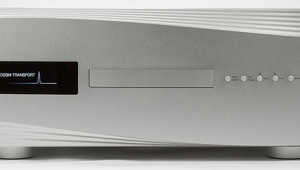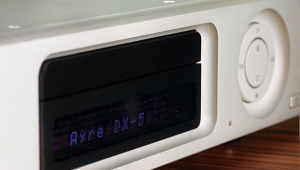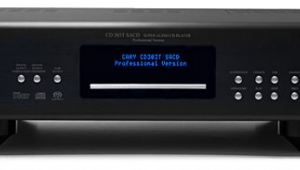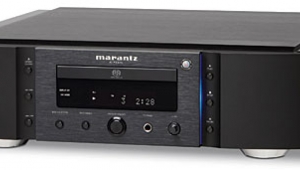| Columns Retired Columns & Blogs |
Sony SCD-1 Super Audio CD/CD player Page 4
Filter 2 has the job of performing "more sophisticated" computations than standard digital filters. As much as possible, "it takes the longest number for calculation processes." This is interesting. Conventional filters truncate or round up and down before passing data to the next stage; "dfil-2" adjusts the length of the input number to match the noise shaper before passing it along. "This way, all nonlinear portions in the computation process are eliminated. Thus, no quantization noise is generated and the data read from the CD retains all of its integrity. Also, there are no longer any nonlinear computations between stages, enabling a powerful sound." These guys were obviously racking up the overtime.
Filter 3 is a new implementation Sony calls an even-number digital filter to take best advantage of the direct 8x oversampling with a 224-order filter. Their explanation is cogent: "Even-number filters use a completely different computation process from conventional odd-number filters. When performing 8x oversampling, an odd-number filter does not process the original data read from the CD. Instead, it makes computations using the interpolation data, which is a sample of 7. In the case of this even-number filter, computation processes are made using the original data read from the CD, and similarly using the interpolated data from the 7 samples. Again, thanks to the VC24's superior computing capability, the 224-order filter enables flat amplification characteristics from 0Hz to 17kHz, regardless of whether [it is] a slow-rolloff type filter or not." That also means they can chop off the top end higher at something over 26kHz.
Filter 4 is a "performance-enhanced" version of "dfil-2." The computational word length is increased by 4 bits, and the filter degree is increased twofold. It's also based on an even-number filter. "These specifications allow dfil-4 to achieve a flat frequency characteristic up to 18kHz for fresh, energetic sound that is full of complexities."
Here's how Sony describes the filter actions in the draft copy of the manual included with the SCD-1: "STD (Standard) provides a wide frequency range and spatial feeling, as it holds the most information among the five filters and is suitable for classical music. Filter 1: Clear (slow rolloff) provides smooth and powerful sound with clear image position and is suitable for jazz band and jazz vocals. Filter 2: Plain (slow rolloff) provides fresh and energetic sound with rich vocal expression suitable for vocal-enhanced music. Filter 3: Fine (slow rolloff) provides a well-balanced natural sound having a feeling of large scale and rich reverberation suitable for listening to any music when you are relaxed." (That's the one!) "Filter 4: Silky (slow rolloff) provides a feeling of wide scale with associated subtleties suitable for classical music, especially if you enjoy fine string touches."
Right on target Sony!
SACD sonics
Kathleen and I hove the SCD-1 up on the same Bright Star Big Rock/Air Mass 2/PolyCrystal rack that normally supports the Spotheim La Luce/SpJ turntable and arm. I leveled the player's formidable mass by inching it around the Rock's top plate and wired it up.
I auditioned the SCD-1 six ways to Sunday. I compared hybrid discs in both SACD and PCM mode on the Sony, then listened to these same hybrid discs in the Forsell Air Bearing and the Burmester transports feeding a dCS 972/Elgar combo upsampling the CD data to 24 bits/192kHz—my absolute reference for digital. When possible, I auditioned the PCM-only versions of recordings in the Sony. I hardly know where to begin.
The bass? Oh, why not.
The quality and power at the bottom were extraordinary from both SACD and CD. The authority, grip, control, pitch definition, and tonal shading, from the stygian depths to the upper midbass, were remarkable. This was much augmented by slamatronic dynamics, in both the micro and macro senses. It was devastating with the Linn Klimax Solo 500 power amplifiers. That was the first clue I had that the analog output stage was indeed something special. The data are on the disc. Great. How do you get them out into the room? Beginning at the very bottom of the frequency range on DSD-encoded material, two incidents tell the tale.
I listened to the Steve Davis Group—my favorite DMP band—on the DMP Does DSD sampler (SACD-03). (The PCM version of these tracks is the Davis Group's Quality of Silence, DMP CD-522, mastered in DSD.) The first Davis piece, "I Thought About You" (track 3), is replete with enjoyable sonic doodads of every kind: delicately struck cymbals over whacking good made-ya-blink drumwork, a mellifluous yet taut and precise guitar, and a rich'n'redolent acoustic bass. Hearing the presence, dimensionality, and air, the way the images formed in our loft in space and time, was an eye- and ear-opening experience. In either SACD or PCM, use this track to check your speaker and front-end's ability to render the acoustic bass's transient-rich and harmonically full acoustic envelope.
Telling Sonic Event No.1 occurred on the sampler's next track, "One Two Free." Mr. Davis enthusiastically works his kickdrum, and some seriously deep bass information was heard (and felt) chunking out of the JMlab Utopias with the beat, as I had heard off Tom Jung's hard drives. It was startling and made everyone jump—especially Tom and Paul Jung, who'd recorded it! According to TJ, as Jung the Elder is affectionately known at DMP, the sound was produced by drummer Davis as his heel thumped the studio floor while driving the rhythm along on his kickdrum. Well, there it was on the sampler, completely undiminished in impact and startle factor. In fact, the same deep-bass transients were re-created very well on the CD layer of the hybrid sampler, if with just a tad less impact and definition.
Back on the SACD layer, I also noted that the tick and shimmer of the cymbals were better rendered than I'd ever heard in my audiophile life. Notes: "If these two tracks don't turn up as demos at the next show, I'll eat my shorts. Sonic profiterole, both of them."
- Log in or register to post comments




































